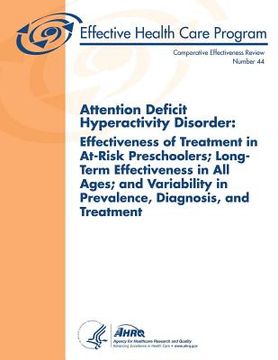Attention Deficit Hyperactivity Disorder: Effectiveness of Treatment in At-Risk Preschoolers; Long-Term Effectiveness in All Ages; and Variability in
Synopsis "Attention Deficit Hyperactivity Disorder: Effectiveness of Treatment in At-Risk Preschoolers; Long-Term Effectiveness in All Ages; and Variability in"
Children with attention deficit hyperactivity disorder (ADHD), a condition characterized by inattention, overactivity, and impulsivity, are most frequently identified and treated in primary school. Population studies indicate that 5 percent of children worldwide show impaired levels of attention and hyperactivity. Boys are classified with ADHD approximately twice as frequently as girls, and primary school-age children approximately twice as frequently as adolescents. ADHD symptoms exist on a continuum in the general population and are considered a "disorder" to a greater or lesser degree, depending on the source of identification (e.g., parent or teacher), extent of functional impairment, diagnostic criteria, and the threshold chosen for defining a "case." The developmentally excessive levels of inattention, overactivity, and impulsivity characteristic of ADHD are present from an early age. However, preschoolers with early signs of ADHD may also have co-occurring oppositional noncompliant behaviors, temper tantrums, and aggression that overshadow symptoms of inattention and overactivity and confound the diagnosis. These behaviors may be given the more general label of disruptive behavior disorder (DBD), which includes oppositional defiant disorder (ODD) and conduct disorder (CD), as well as ADHD. If not already identified at an early age, preschool youngsters with ODD frequently meet criteria for ADHD by grade school. The purpose of this review is to (1) critically examine the effectiveness and adverse events of interventions in preschool children with clinically significant disruptive behavior and therefore at high risk for ADHD; (2) critically examine the comparative long-term effectiveness and adverse events of interventions for ADHD (pharmacological, psychosocial, or behavioral, and the combination of pharmacological and psychosocial or behavioral interventions); and (3) summarize what is known about patterns of identification and treatment for the condition. Factors to be examined include geography, sociodemographics, temporal aspects, and provider background. This systematic appraisal also identifies gaps in the existing literature that will inform directions for future research. The Key Questions (KQs) are as follows. KQ1. Among children younger than 6 years of age with ADHD or DBD, what are the effectiveness and adverse event outcomes following treatment? KQ2. Among people 6 years of age or older with ADHD, what are the effectiveness and adverse event outcomes following 12 months or more of any combination of followup or treatment, including, but not limited to, 12 months or more of continuous treatment? KQ3. How do (a) underlying prevalence of ADHD and (b) rates of diagnosis (clinical identification) and treatment for ADHD vary by geography, time period, provider type, and sociodemographic characteristics?

